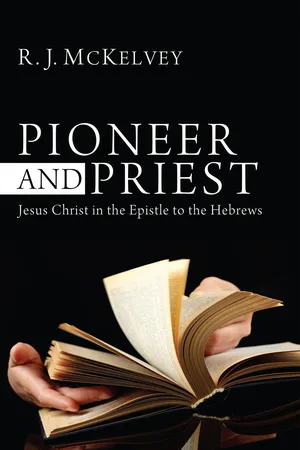1
Why Hebrews?
The aim of the homily, like its authorship and provenance, addressees, and date, is a challenge and a subject of continuing debate among scholars. It is best that we learn from Hebrews by interpreting it on its own terms. This means attempting to relate the author’s description of the letter as a “word of exhortation (paraklēseōs)” (13:22) to what precedes it. The systematic way in which theological exposition is followed by practical instruction, and itself contains practical admonitions, shows very clearly that the author of Hebrews wrote very specifically with the aim of helping the troubled community. His work is a good example of how theology and pastoralia interact. For our purpose it is instructive to find that the author’s response to pastoral life situation is directly related to his deployment of the titles and functions of “pioneer” and “priest.”
The author begins by praising and encouraging the addressees. He recalls the help they gave to others in trouble (6:9–11; 10:34) and recalls how they had stood a severe test as Christians, “sometimes being publicly exposed to abuse and persecution and sometimes being partners with those so treated” (10:33). He remembers how they had risked getting into trouble by befriending those in prison (10:34). Their property had been plundered. In spite of everything the wonderful thing was that their joy had not been spoilt (10:34).
But the author moves quickly to the problems affecting the congregation. Some of its members were tempted to drift away and neglect their Christian confession (2:1; 3:12; 6:4–6; 10:35, 39). They lacked a firm hope (3:6; 6:11; 10:23), and they were in danger of losing their confidence (3:14; 10:35). They were failing to make progress in their understanding of the Christian faith (5:11–6:2) and they had become disenchanted and lethargic (5:11; 6:12). Tragically, some were no longer worshipping with the rest of the community (10:25).Worse still, apostasy was a real threat (6:6; cf. 3:12; 9:14). Lax moral standards were harming the life of the church (13:4–5). Concern over the delay of the return of Jesus Christ also was a problem (9:27–28; 10:25).
Clues to the aim of the author are to be found in the numerous contrasts drawn between Christ and the people and institutions of the old covenant (angels [1:5–14]; Moses [3:1–6]; the high priest [5:1–10; 7:1–28]; Christ in the heavenly sanctuary [8:1–5,6–9]; the old covenant and the new [8:8–9:22]; Christ’s offering [10:1–14]; God’s pilgrim people [11:39–40]; Sinai and Mount Zion [12:18–24]; outside the city gate [13:10–12]).These contrasts reveal that the recipients needed to have a much clearer understanding of Jesus Christ and make a greater commitment to him.
The traditional view that the recipients were in danger of lapsing back into Judaism has come in for reappraisal, not only because there is nothing in the writing that supports this but because Hebrews was written well before Christianity broke apart from Judaism to go its own way.
More credible is the suggestion that the recipients had some connection with members of the local synagogue, possibly operating as a house church within its precincts, and were having difficulty in fully appreciating their Christian identity and maintaining their Christian confession vis a vis Judaism. This is attributed to a failure to understand the uniqueness of Christ and the new faith or a fear of persecution. Persecution of some sort had been experienced (10:32–33; cf. 12:3–11), and this may have resulted in reluctance to venture “outside the camp” and suffer abuse for Christ (13:13). Much is to be said for the view that the author is urging the recipients not so much as to fall back into Judaism but to make progress in their understanding of Christ and devotion to him and to become independent of the synagogue.
Odd as it has seemed to many readers of Hebrews it is suggested that the recipients were Gentile Christians. This is based on the assumption that appeals not to fall away from the living God (3:12), avoid “dead works” (9:14) and “strange teaching” (13:9) could only apply to Gentiles. But care is needed here. Jews in the Greco-Roman world not infrequently absorbed influences from their cultural context. The “strange teachings” referred to in 13:9, in a context which reflects an incontestably Jewish background, suggests this possibility. On the other hand, it should not be automatically assumed that what the author says about Levitical cultus is addressed exclusively to Jewish Christians. Gentiles who were God-fearers could very well have been members of the church. As converts to Judaism they would have been expected to accept the Scriptures as the record of the divine revelation and may hav...
